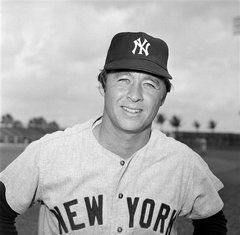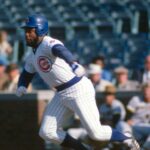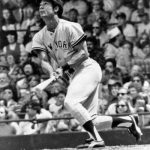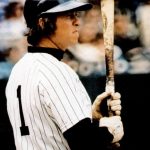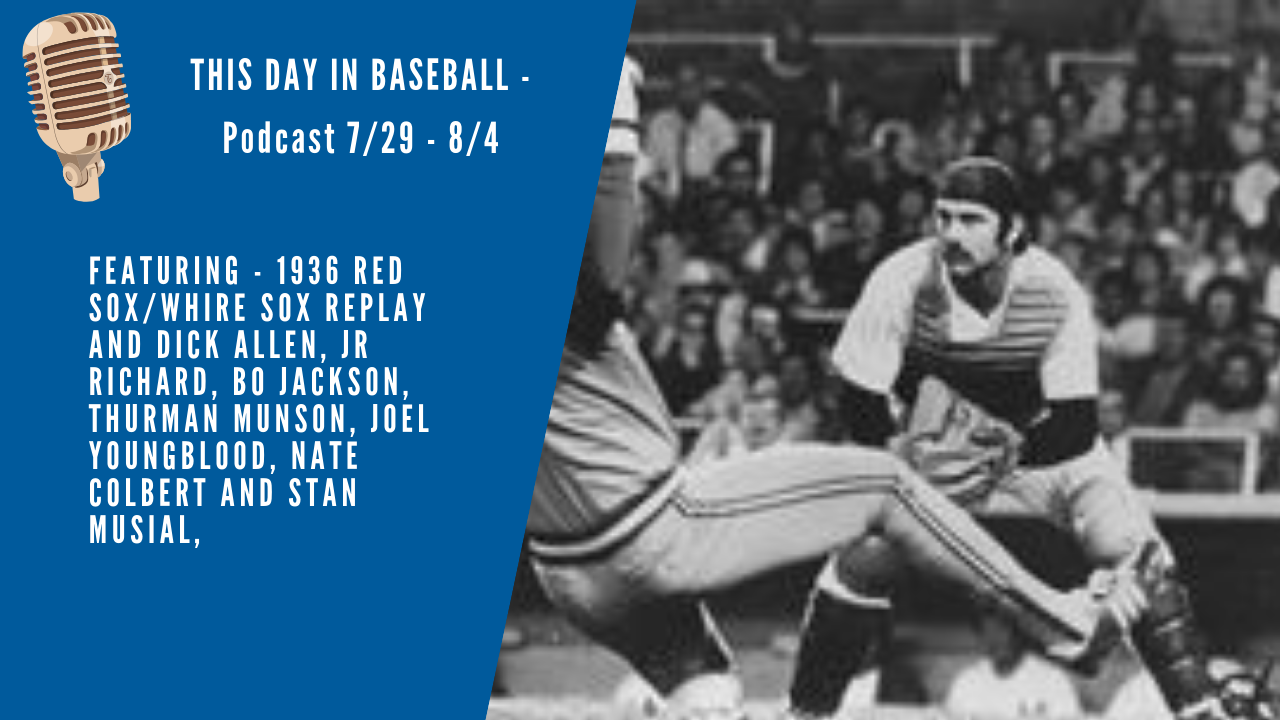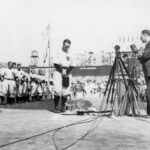Bobby Murcer Stats & Facts
Bobby Murcer
Position: Outfielder
Bats: Left • Throws: Right
5-11, 160lb (180cm, 72kg)
Born: May 20, 1946 in Oklahoma City, OK
Died: July 12, 2008 in Oklahoma City, OK
Buried: Rose Hill Cemetery, Oklahoma City, OK
High School: Southeast HS (Oklahoma City, OK)
School: University of Oklahoma (Norman, OK)
Debut: September 8, 1965 (10,023rd in MLB history)
vs. WSA 4 AB, 0 H, 0 HR, 0 RBI, 0 SB
Last Game: June 11, 1983
vs. MIL 1 AB, 0 H, 0 HR, 0 RBI, 0 SB
Full Name: Bobby Ray Murcer
View Player Bio from the SABR BioProject
Card Collections ENDING SOON ON EBAY
MOST WANTED ROOKIE CARDS
VINTAGE SPORTS TICKETS
Baseball Hall of Famers
Nine Players Who Debuted in 1965
Lee May
Mark Belanger
Bobby Murcer
Roy White
Steve Carlton
Tug McGraw
Fergie Jenkins
Jim Palmer
Catfish Hunter
All-Time Teammate Team
Coming Soon
Notable Events and Chronology for Bobby Murcer Career
One of the most popular players ever to wear a New York Yankee uniform, Bobby Murcer entered the major leagues with the immense pressure of trying to replace Mickey Mantle as the team’s next true superstar. Although Murcer failed to reach the same level of greatness his Yankee predecessor attained over the course of his career, he eventually developed into the team’s finest all-around player and an outstanding major leaguer. A five-time All-Star and the American League’s 1972 leader in both runs scored and total bases, Murcer had three tours of duty in New York, bridging the gap between two distinct generations of championship Yankee teams.
Biography
Born in Oklahoma City, Oklahoma on May 20, 1946, Bobby Ray Murcer attended local Southeast High School, where he starred in baseball, football, and basketball. After signing a letter of intent to play for the Oklahoma Sooners, Murcer instead chose to sign an amateur free agent contract with the Yankees in June of 1964. Murcer later recalled, “The Yankees offered me $10,000 less than the Dodgers did. I thought ‘ I’ll just make it up in World Series money…no big deal.'”
Biography:
Little did Murcer know at the time that the 1964 campaign would mark the end of the Yankee dynasty. After earning Carolina League MVP honors with New York’s Greensboro affiliate in 1965, Murcer joined a Yankee team late in the year that found itself firmly entrenched in the American League’s second division. Playing all his games at shortstop, the 19-year-old saw limited action down the stretch, appearing in only 11 contests, coming to the plate a total of just 37 times, batting .243, and hitting his first major league home run. Murcer also joined the team briefly at the end of the 1966 season, batting just .174 in 69 at-bats.
Murcer’s first experience at the major league level was a difficult one. Having grown up in Oklahoma, he seemed intimidated by the big city. Furthermore, he appeared to be a bit overwhelmed by the expectations the team placed on him at the tender age of 19, when it began referring to him as “The Next Mickey Mantle.” In truth, Mantle and Murcer did share certain similarities. They were both from Oklahoma. They were both signed by the same scout, Tom Greenwade. And they both originally came up as 19-year-old shortstops. But that is where the similarities between the two men ended since, although Murcer was a gifted athlete, he had neither the awesome power nor the blinding speed that Mantle possessed in his youth.
Return from Army
Called into the Army at the end of the 1966 campaign, Murcer missed each of the next two seasons. However, his stint in the military turned out to be a blessing in disguise since Murcer returned to the Yankees a new man in 1969. More mature both mentally and physically, Murcer seemed much better prepared to play baseball at the major league level. Reflecting back on his military experience, Murcer said, “I think, all in all, it helped me – not only as a player, but also as a man – because, when I came back, I was much more ready to handle the rigors and the pressures of playing professional baseball, maturity-wise.”
Still, Murcer had the unenviable task of trying to replace Mickey Mantle as the team’s next great player. Adding to the pressures placed on Murcer by fans and the media were the high expectations the team itself thrust on him when it assigned him the recently-retired Mantle’s old locker. Playing under close scrutiny, Murcer handled himself rather well his first two seasons. After struggling defensively at third base early in 1969, Murcer moved to centerfield, where he found a home. As he continued to learn his new position, Murcer put up solid offensive numbers, combining for 49 home runs, 160 runs batted in, and 177 runs scored in 1969 and 1970. Nevertheless, his batting averages of .259 and .251 disappointed Yankee fans, as did his strikeout totals of 103 and 100. Before long, Murcer found himself the occasional target of boos emanating from the stands in his home ballpark.
Blossoming into a star
However, Murcer turned the boos into cheers in 1971, a season during which he developed into one of the American League’s finest all-around players. After constantly trying to take advantage of Yankee Stadium’s short right-field porch by pulling the ball his first two seasons, the left-handed-swinging Murcer evolved into a more complete hitter in 1971. As former Chicago White Sox outfielder Carlos May said, “He (Murcer) was tailor-made for that ballpark. He hung over the plate, and anything inside – lookout – home run.”
Correspondingly, opposing pitchers usually pitched Murcer outside, causing him to frequently strike out or hit weak ground balls to the right side of the infield. Learning from his earlier mistakes, Murcer began hitting the ball more to left-field in 1971, allowing him to become one of the junior circuit’s elite hitters.
Discussing Murcer’s maturation as a hitter, former Yankee pitcher Al Downing stated, “After about 2 ½ years the bell goes off and you say ‘Why am I fighting myself? Just relax and do what I’m capable of doing.’ I think that’s what happened with Bobby. He settled in and became an outstanding ballplayer.”
Murcer raised his batting average 80 points in 1971, finishing a close second to Tony Oliva in the American League batting race with a mark of .331. He also hit 25 home runs, drove in 94 runs, scored 94 others, and cut his strikeout total down to just 60. Murcer’s .427 on-base percentage led the American League, and he also finished second in slugging percentage and runs scored, third in total bases, and fourth in runs batted in. His strong throwing arm also enabled him to finish near the top of the league rankings in outfield assists for the second of five consecutive times. Murcer’s exceptional all-around performance earned him his first selection to both the American League and The Sporting News All-Star Teams, and, also, a seventh-place finish in the league MVP voting.
Murcer had another outstanding season in 1972, batting .292 and establishing career highs in home runs (33), runs batted in (96), and runs scored (102). He led the American League in runs scored and total bases, and he also placed among the leaders in five other offensive categories. Murcer earned his second consecutive selections to the American League and The Sporting News All-Star Teams, won the only Gold Glove of his career for his outstanding defense in centerfield, and finished fifth in the league MVP voting.
Move to Shea Stadium
After another fine season in 1973 in which he hit 22 homers, knocked in 95 runs, batted .304, finished ninth in the league MVP balloting, and earned his third straight A.L. and Sporting News All-Star selections, Murcer’s performance slipped somewhat in 1974. With the team moving to Shea Stadium for two seasons as Yankee Stadium underwent major renovations, Murcer had a difficult time adjusting to the swirling winds and more distant right-field fence in Queens. Many balls he pulled to right-field that would have been home runs in Yankee Stadium were caught on the warning track in Shea, resulting in a career-low total of only 10 homers for Murcer. He also scored just 69 runs and batted only .274. Yet, he still managed to lead the team with 88 runs batted in, do anexcellent defensive job in right-field after surrendering his prestigious spot in center to Elliott Maddox, and earn his fourth straight selection to the A.L. All-Star Team.
Leaving New York
Concerned that Murcer appeared to be losing his power stroke, the Yankee front office made a move on October 22, 1974 that stunned both the outfielder and fans of the team. General Manager Gabe Paul informed the team’s most popular player early that morning that he had been dealt to the San Francisco Giants for star outfielder Bobby Bonds. Distraught after hearing the news, Murcer swore never to forgive the Yankees, who he had always held close to his heart.
Murcer later recalled: “I was devastated by leaving the Yankees and the pinstripes, and I just didn’t feel in my own mind that I belonged any other place but playing for the Yankees.”
After recovering from the initial shock, Murcer ended up having a solid season for the Giants in 1975. Although playing in cold and windy Candlestick Park limited him to only 11 home runs, Murcer knocked in 91 runs, batted .298, struck out only 45 times in 526 at-bats, walked 91 times, and earned a spot on the National League All-Star Team. After another productive season with the Giants in which he hit 23 homers and drove in 90 runs, Murcer was traded to the Cubs for two-time defending N.L. batting champion Bill Madlock.
Return to the Big Apple
Murcer posted good numbers in Chicago in both 1977 and 1978, but the 32-year-old outfielder began to see his playing time diminish in 1979 – a year in which he collected only 190 at-bats during the first half of the season. Still longing for a return to New York, Murcer jumped at the opportunity Chicago’s GM presented to him when the latter suggested that the Yankees had expressed interest in reacquiring the outfielder. Murcer returned to the team and city he loved so dearly on June 26, after the Yankees obtained him for a minor league pitcher and cash. Murcer’s return to the organization turned out to be a stroke of fate, since it reunited him with former teammate and close friend Thurman Munson, who died tragically in a plane crash just six weeks later.
After rejoining the Yankees, Murcer briefly took over the starting centerfield job from the recently-departed Mickey Rivers, who had been traded to Texas for Oscar Gamble. He then moved to left-field to make room for young outfield prospect Bobby Brown. Playing regulary the remainder of the season, Murcer hit eight home runs, knocked in 33 runs, and batted .273 in 264 at-bats with the Yankees. He received one of his greatest thrills two years later when he appeared in the World Series as a member of the team that originally signed him. Reflecting back on his lone trip to the Fall Classic, Murcer said, “Being in a World Series in Yankee Stadium, that was a dream come true.”
Murcer remained with the team another two years, serving mostly as a part-time designated hitter and pinch-hitter. He retired early during the 1983 campaign to make room on the roster for a young prospect named Don Mattingly. Murcer was immediately given a job in the broadcast booth as an announcer, a position he held for more than 20 years.
Legacy
Bobby Murcer never quite reached the level of greatness many people predicted for him early in his career. Nevertheless, he was a very good player for quite a few seasons, and he was New York’s best player throughout much of his first tenure with the team. In addition to earning five league All-Star and three Sporting News All-Star selections, Murcer placed in the top ten in the MVP voting three times. He finished in the league’s top five in hits and total bases three times each, runs batted in, runs scored, batting average, slugging percentage, and bases on balls two times each, and home runs and on-base percentage once each. He also led all league outfielders in assists on two separate occasions. Murcer finished his career with 252 home runs, 1,043 runs batted in, 972 runs scored, and a .277 batting average.
Still, former Yankee teammate Roy White expressed the belief that Murcer would have posted significantly better numbers had he remained in New York throughout his entire career. White suggested, “If Bobby would have had a chance to play his whole career with the Yankees, he would have had some great numbers. He probably could have added close to another 150 home runs onto his home run total because he had a great swing for Yankee Stadium – a very compact, short stroke. Him getting traded and going to the other teams, I think it hurt his overall numbers. I think he could have been that much greater a player if he could have been with us. Plus, he was really upset about leaving New York. In his heart he was all Yankee.”
In addition to putting up solid numbers during his time in New York, Murcer often demonstrated that he had a flair for the dramatic. He hit three home runs in a game twice as a member of the Yankees, accomplishing the feat for the first time during a doubleheader against the Cleveland Indians in June of 1970. After homering against Sam McDowell in his final at-bat of the first contest, Murcer hit three consecutive homers in the nightcap, making him one of only four Yankee players in history to hit home runs in four consecutive at-bats (Lou Gehrig, Johnny Blanchard, and Mickey Mantle were the others). In August of 1972, Murcer became the first Yankee to hit for the cycle since Mickey Mantle accomplished the feat 15 years earlier.
Murcer also demonstrated his ability to provide special moments on August 8, 1977, as a member of the Chicago Cubs. After promising by telephone earlier in the day to try and hit a home run and a double for terminally ill fan Scott Crull, Murcer hit two home runs against the Pittsburgh Pirates. Broadcasting the game nationally on ABC television, Keith Jackson described to the country the manner in which Murcer had fulfilled the dying boy’s last wish.
Relationship with Thurman Munson
However, perhaps Murcer’s most memorable achievement came on August 6, 1979, just four days after his close friend Thurman Munson died in a plane crash. Earlier that very same day, Murcer and Lou Piniella both delivered eulogies at their team captain’s funeral. Included in Murcer’s eulogy were the words: “…Someday the Yankees may have another captain…no greater honor could be bestowed on a man than to be a successor to this man.”
He added, “Thurman Munson, who wore the pinstripes, was number 15, but in living, loving, and legend, history will record my friend as Number 1.”
Following the service, the team seriously considered cancelling that evening’s game against the Baltimore Orioles. New York finally decided to go through with the nationally televised contest, though, after Murcer went to George Steinbrenner and told him of Diane Munson’s request. Murcer had spent the previous evening at the Munson home, and the widow of the Yankees’ fallen captain informed him that she wanted the team to play the next day because her husband would have wanted it that way. Piniella found himself too distraught to play that evening, but fellow euglogist Murcer felt differently. Even though he broke into tears while delivering his eulogy, Murcer told manager Billy Martin that, for some reason, he felt as if he needed to play that night.
With the Yankees trailing Baltimore 4-0 in the bottom of the seventh inning, Murcer hit a three-run homer to right-field to close the gap to 4-3. Then, coming up in the bottom of the ninth with runners on second and third and no one out, Murcer continued his heroics by winning the game with a line-drive, two-run single to left-field.
Looking back on the events of the evening, Murcer later recalled, “It was a special night, and sometimes extraordinary things happen on special nights. Was it meant to be? Maybe it was…I don’t know.”
He then added, “I do know one thing, that after the game, the bat that I used that night I never did use again. In fact, I gave it to Diane (Munson). This was special for me, special for Thurman, and whatever this bat produced needed to be in the Munson family, so I gave it to her.”
Death
Bobby Murcer’s mettle was tested again some 30 years later when he was diagnosed with a brain tumor on Christmas Eve, 2006. He underwent surgery a few days later, after which he learned that the tumor was malignant. Murcer made his first post-operative appearance on fellow Yankee broadcaster Michael Kay’s radio show on January 23, 2007. After being interviewed by Kay and taking telephone calls from listeners, Murcer ended the conversation by saying, “I want to thank you very much for giving me the forum to do this because I wanted you to know that, even though this looks bad, I’m doing great. I really am. I’m in a great place. God has given me peace and the overwhelming love has been insurmountable for me to even deal with. I can feel the fans. I can feel their thoughts and their prayers, and I wanted to tell them how much I love them.”
Murcer returned to work in the Yankee television booth on May 1, 2007 and spent the remainder of the year announcing games for the team. In late February 2008, an MRI scan led Murcer’s doctors to perform a biopsy, which happily revealed scar tissue instead of a recurrence of brain cancer. However, Murcer suffered a relapse some four months later and passed away on July 12. Murcer’s death came only months after he released his autobiography, which was ironically entitled Yankee For Life.
Bobby Murcer’s memorial service was held in Edmond, Oklahoma on August 6, 2008, 29 years to the day after he delivered his eulogy at Thurman Munson’s funeral. Diana Munson attended the service, during which the uniform worn by Murcer at his final Yankee Stadium Old Timer’s Day appearance in 2007 was presented to his spouse Kay.
No, Bobby Murcer may never quite have developed into one of the greatest players in Yankee history, but he certainly was one of the classiest and most beloved men to ever don the pinstripes.
@ET-DC@eyJkeW5hbWljIjp0cnVlLCJjb250ZW50IjoicG9zdF90YWdzIiwic2V0dGluZ3MiOnsiYmVmb3JlIjoiTGVhcm4gTW9yZSBhYm91dCB0aGUgdGVhbXMsIHBsYXllcnMsIGJhbGwgcGFya3MgYW5kIGV2ZW50cyB0aGF0IGhhcHBlbmVkIG9uIHRoaXMgZGF0ZSBpbiBoaXN0b3J5IC0gLSAtIC0gLSAtIC0gIiwiYWZ0ZXIiOiIiLCJsaW5rX3RvX3Rlcm1fcGFnZSI6Im9uIiwic2VwYXJhdG9yIjoiIHwgIiwiY2F0ZWdvcnlfdHlwZSI6InBvc3RfdGFnIn19@
Card Collections ENDING SOON ON EBAY
MOST WANTED ROOKIE CARDS
VINTAGE SPORTS TICKETS
Baseball Hall of Famers
Factoids, Quotes, Milestones and Odd Facts
Coming soon
Other Resources & Links
Coming Soon
If you would like to add a link or add information for player pages, please contact us here.

